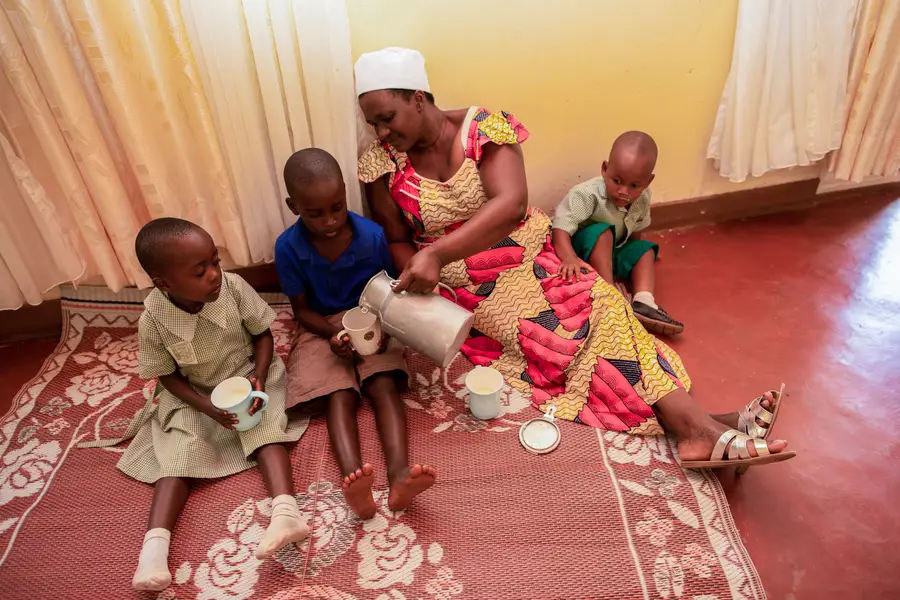
Angelica Mukayizere is a milk collection manager for Green Foods, a USAID-supported agribusiness in Rwanda that produces dairy products. Angelica supports her family using money from her job. Photo by Ellie Van Houtte for RTI International
Women play an incredibly important and complex role in global nutrition. As contributors within a household and economy, and in their role as child bearers, it is critical that they be both a recipient and a provider of good nutrition in order to perpetuate a cycle of adequate nourishment.
In advance of International Women’s Day, we sat down with RTI’s Chessa Lutter, a global nutrition expert, to talk about what this complex relationship between women and nutrition means in practice.
What is the connection between empowering women and improving global nutrition?
From a social and economic perspective, women are largely the ones responsible for caring for babies and children within a household. They must have access to the right resources at the right time to make decisions about their health, be able to access education, and have decision-making power to be able to help their families build the nutrition profile that will allow them to thrive.
Much of my research has focused around early childhood nutrition—both breastfeeding promotion as well as the introduction of nutritious and safe foods, such as those derived from animal proteins, at the appropriate time in a child’s life. Good nutrition early in life, especially during the 1,000-day window from pregnancy to a child’s second birthday, promotes brain development, which can have short- to medium-term health implications as well as long-term repercussions for a society’s human capital.
Empowering women with access to family planning resources can also have a significant impact on maternal and child nutrition. This is especially true for adolescent girls, who are at high risk to experience complications during pregnancy, and whose infants have a higher likelihood of low birthweight, malnutrition, stunting, and mortality. Child-birth related complications are the leading cause of death worldwide among girls aged 15 to 19. Access to family planning information and services can help minimize high-risk pregnancies, as well as educate women and girls about the benefits of exclusive breastfeeding, good nutrition, and birth spacing, or allowing sufficient time between pregnancies so mothers can heal and restore essential nutrients, which has known benefits for the health and wellbeing of their children.
Women also play an important role in many aspects of the agri-food system—from research to farming to processing and selling food. In order to be successful in those economic endeavors, women must be able to access the same productive resources—such as time, land, new technology, and financial capital—as their male counterparts. For many reasons, ranging from familial to cultural, women are sometimes not afforded such access, making them unable to contribute to and benefit from household income in the same way men might. There is evidence that such economic empowerment for women, including more control over family income, leads to increased household investment in nutritious food and education for children.
Why is it so important that women themselves be recipients of good nutrition?
Women are the ones who bear children, so keeping women healthy and well-nourished, especially from the time they’re of childbearing age, is important. According to the most recent Global Nutrition Report, one-third of all women of reproductive age are anemic, putting them at risk of death from post-partum hemorrhage. At the same time, globally, women are more likely to experience obesity than men, which can lead to weight-related non-communicable diseases.These statistics are important not only for women’s own health, wellbeing, and economic productivity, but also because a mother’s nutrition affects her child’s health while it’s still in the womb, and poor health after that can inhibit anyone’s ability to provide adequate caregiving to young children.
After a child is born, we must ensure that caregivers—who are most often women—are able to consistently and adequately nourish themselves and their children, from birth until the time those children leave the home.
Good nutrition is also needed to support women’s ability to lead productive lives outside the home, including through income-generating activities that can in turn benefit household income and, potentially, household nutrition.
What can we do to improve nutrition for women and their families worldwide?
We’re still building the evidence base around what works best to empower women for improved nutrition around the world, which is complicated by the various historical, cultural, and even legal factors that play out in different contexts.
For our part, my RTI colleagues and I will continue to contribute to that evidence through both research and programmatic work. For example, my own previous studies have focused on providing mothers access to and education about animal-source foods and have shown promise that such interventions can improve young child nutrition.
RTI is also working to empower women and their families by expanding access to high-quality, integrated family planning and maternal, neonatal, child health and nutrition services as part of the USAID-funded ReachHealth project in the Philippines.
How best to empower women—and harness that empowerment to contribute to transformative improvements in nutrition—is one of the “million-dollar questions” in international development. Generally, we all agree that empowering women makes sense economically, socially, and health-wise. What we do know is that no one intervention alone can solve the problem. We must continue to strive toward greater collaboration and integrated programming that can break down barriers that prevent women and girls from achieving healthy futures for themselves and their families.
